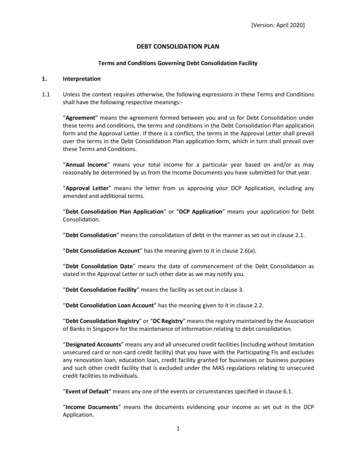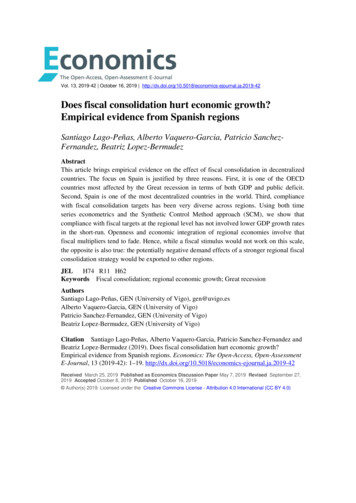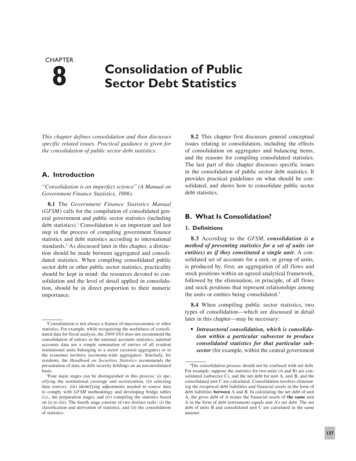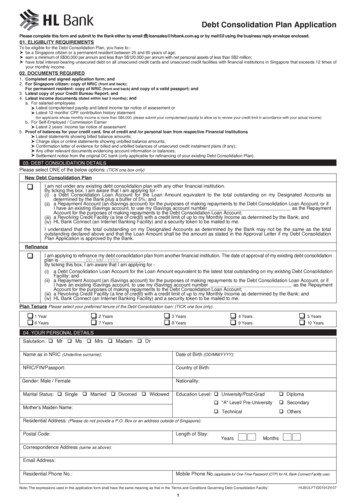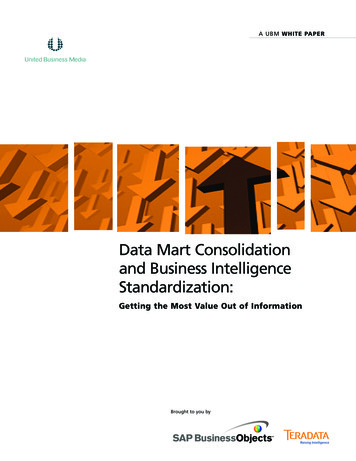
Transcription
A UBM WHITE PAPERData Mart Consolidationand Business IntelligenceStandardization:Getting the Most Value Out of InformationBrought to you by
Data Mart Consolidationand Business IntelligenceStandardization:Getting the Most Value Out of Information2Executive SummaryMaking information more broadly and easilyavailable to more users throughout anorganization—and beyond the organizationto customers, business partners and otherstakeholders—has never been a more strategic corporate imperative. In growing numbers,enterprises are coming to understand thevalue of placing consistent, integrated datainto the hands of everyone who needs it.ContentsExecutive Summary2Data MartConsolidation2BI Standardization4Moving toOperationalBusinessIntelligenceExtending BusinessIntelligence toSuppliers andCustomersA PowerfulPartnership5Having cross-functional data makes informationmore easily and broadly accessible and creates a360-degree view of customers, productsand services. As a result, businesses can gain a competitive advantage by improving the productivity ofemployees and making more informed decisions.Ultimately, they can better serve their customersand enhance working relationships with businesspartners.Organizations can gain this cross-functionalview of data and realize greater business valuethrough the consolidation of data marts, operational data stores and other informationsources, combined with the standardization ofbusiness intelligence (BI) tools that access thisinformation.Among the key benefits of launching a datamart consolidation and BI standardization strategyare cost savings, cost avoidance and better returnon IT investments. But, by far, the greatest value isthe improved decision making that drives competitive differentiation. This white paper fromSAP BusinessObjects , Teradata Corporation andUBM Technology describes data mart consolidationand BI standardization, and the benefits that 77TM hundreds of organizations are already realizingfrom these efforts.D ATA M A R T C O N S O L I D AT I O NThe consolidation of data marts, operationaldata stores (ODS) and other data sourcesproduces a single, consistent, integrated andaccurate view of the data within an organization.Among the multiple data strategies an organizationcan deploy to manage its data, creating an enterprise data warehouse (EDW) that consolidatesand integrates data is optimal because it providesa single view of the business.Many organizations have built multiple datamarts to serve different areas of the business.Often, these marts have been created with anarrow departmental scope, typically focusingon a single application or subject area, such assales, marketing or finance. Data marts are easierto build because there’s less corporate process.Therefore, data marts tend to multiply quicklyand become more costly, especially in largerorganizations.Organizations have also created multipleoperational data stores, which are similar to datamarts in that they combine subject-specific datafrom many sources, but differ in that they alwayshave the most up-to-date version of the data.While data marts and ODSs provide value forspecific user groups and areas of the business,they cannot be leveraged across the organization.As a result, they introduce the potential for inconsistent and even conflicting information across theorganization, because they are not connected andare gathering and interpreting data from multiplesources, which may define data differently and
UBM WHITE PAPER Data Mart Consolidation and Business Intelligence Standardization3receive updates on different time intervals.Additionally, these various data marts rely on multiple hardware systems and software, increasing ITmaintenance and support costs.Teradata research indicates that 59 percentof companies maintain up to 30 data marts—andsome companies have as many as 100 or more.Industry studies show that it can cost in the rangeof 1.5 million to 2 million annually to maintaina single data mart. Anywhere from 35 percent to70 percent of those costs are redundant.Data mart consolidation is the process ofcentralizing data from multiple, disparate sourcesinto a single, centralized enterprise data warehouse (EDW) that can be accessed by anyone inthe organization who needs the information.Unlike a departmental data mart, an EDW iscreated with an enterprise scope, supports multiple subject areas and applications across anorganization and leverages consistent definitionsof the data. By merging data from multiplesources onto one platform, organizations canretain the functional capabilities of the originalsources while broadening the business value ofthe data to other parts of the organization.Consolidating data marts and ODSs into asingle EDW significantly reduces the hundreds ofthousands of dollars in cost per data mart forassociated hardware, software, tools, processesand personnel. As demand rises for more information and applications, a centralized EDW canprovide solutions faster and more cost effectivelythan building an additional data mart becausethese new applications can leverage the dataalready in the EDW.Another benefit of data mart consolidationis that organizations can better address information security and regulatory compliance. By havingcritical data stored in a centrally managed warehouse, rather than distributed across differentplatforms in multiple locations, central IT organizations can more easily secure the informationand keep track of access controls.The most significant benefit of data mart consolidation is a single view of data, which results inmore accurate information and enables smarterdecision making. “This is one of the key businessdrivers of consolidation for our customers,” saysRandy Lea, vice president of product and servicemarketing at Teradata. “They want a 360-degreeview of their business—at the customer level, atthe product level and at the service level—foreveryone in the enterprise. And they haven’t beenable to achieve that with a data mart approach orother data warehouse solutions.”“When you look at a customer, you have tolook not only at the purchases the customer hasmade but also at their experience, profitabilityand your strategy for dealing with thatcustomer,” Lea says. For example, if an airlinecompany knows how much a customer flies withthe airline, how much the customer pays for ticketsand how profitable the customer is, it can givedifferentiated treatment to that customer.BUSINESS IMPACT MODELS MEASURE BUSINESS VALUETeradata Corproration offers patent-pending Business Impact Models (BIMs), which are sophisticated predictivefinancial models to help organizations define and measure the quantifiable business value of Teradata solutions.These models enable companies to examine specific scenarios or business problems and see how an integrated datasolution can pay off for the organization with smarter decision making.Teradata has developed a specific BIM for data mart consolidation. It accurately measures the cost savings as wellas the revenue lift that can be anticipated from consolidating data marts into a centralized enterprise data warehouse. This model uses industry-specific averages as well as data provided by the customer (such as the number ofdata marts, costs, personnel, etc.) to determine the potential cost savings for a specific environment, inclusive of allthe costs to migrate. Use of the model is flexible and can be based on the depth of the analysis required to meeteach customer’s needs.The outcome of an assessment using the BIM is an impartial, rigorous, detailed report outlining the tangible ROI tobe realized from consolidating candidate data marts. The report includes the customer’s existing cost infrastructurefor multiple data marts, an estimate of the cost to migrate those marts onto a centralized architecture (includingongoing maintenance), and projections for cash flow, Net Present Value (NPV), ROI.Teradata Data Mart Consolidation BIM can be used in conjunction with other Teradata industry-specific BIMs to predictrevenues after consolidation is complete.
UBM WHITE PAPER Data Mart Consolidation and Business Intelligence Standardization“If these different pieces of information reside indifferent data marts, the decision-maker isimpaired and may make bad decisions that do nothelp, or worse yet, hurt the business,” Lea says.There are two basic ways to consolidatedata marts. The first is to simply re-host existingdata models onto a centralized platform to eliminate redundant hardware and software and theassociated support and maintenance costs.“Consolidating platforms can bring tremendouscost savings to the organization,” Lea says.“However, the data itself is not necessarily“The greatest value of consolidation is the businessinsight and competitive advantage that a 360-degree view delivers.”— Randy Lea, Teradata4integrated. Rather the data models coexist on acentralized system.”The second and more effective approach toconsolidation includes data integration and thecreation of a single physical and logical datamodel to support the enterprise. “This methoddrives not only cost savings, but also delivers thebusiness value that comes from an integrated,cross-functional view of your business,” Lea says.When data integration is added to the mix,organizations can eliminate data redundancyand reduce operational complexity. Many organizations handle consolidation in a two-stepprocess, first bringing data marts (e.g., structure)together on a centralized system, which is thenfollowed by the data model integration.With nearly 30 years of experience in buildingEDWs, Teradata has an immense amount ofknowledge about the underlying models and hascaptured that knowledge in enterprise, industryspecific logical data models (LDMs) that model theenterprise data, data relationships, topic areas andbusiness rules relating to enterprise IT. Thesemodels are pictures of all the pieces of information necessary to run the business.“Our LDMs are tremendously valuable toour customers,” Lea says. “If they have to createa data model from scratch, it will cost them hundreds of thousands of dollars and require sixmonths to 18 months of work.”In addition to providing industry-leadingenterprise data warehouse technology, such asLDMs, Teradata provides a suite of assessmentservices, migration tools, customer educationand business impact models (BIMs) to helporganizations calculate the ROI of combining disparate data marts into a central, integrated datawarehouse. (See the sidebar, “Business ImpactModels Measure Business Value,” for additionalinformation.) To date, Teradata has helped some120 customers consolidate a total of more than600 data marts.Teradata’s data mart consolidation programis a two-tiered assessment. It starts with a Webbased Quick Assessment tool to make somebasic assumptions about the consolidation and isfollowed by a more detailed assessment. Duringthis assessment, a project plan is developed, providing the customer with a roadmap for themigration of data, processes and applications toa centralized EDW.Companies that have all their data in oneanalytical repository driving all business decisions,both strategic and operational, from a commonsource, have an advantage over their competition.“This is what we refer to as ‘Active EnterpriseIntelligence’ or AEI,” says Stephen Brobst, chieftechnology officer for Teradata. “AEI is the extension of the warehouse from traditional strategicqueries to front-line workers who can benefitfrom tactical, operational queries.”Teradata delivers AEI through its deploymentof Active Data Warehousing (ADW) technology.AEI is a business strategy to integrate intelligencethroughout the enterprise, aligning strategicdecision making and operational execution. AEIdistinguishes between two kinds of intelligence:strategic intelligence that’s generated and usedby traditional data warehouse users such as executives, marketing managers, product analystsand financial managers, and operational intelligence that’s leveraged by front-line workers,such as customer service representatives, retailcashiers, bank tellers, loading dock workers andcall center agents (see more on Operational BI inthe section below). The goal of the AEI strategyis to increase alignment through better integration of decision making.B I S TA N D A R D I Z AT I O NNot only can organizations benefit from centralizing their data in enterprise data warehousesand, thereby, gain confidence in the accuracy ofthe information, but they can also maximize theuse of that information with a comprehensive,standardized business intelligence (BI) platform.The standardization of BI tools provides greatercontrol over information and better alignment ofIT with business users.As with data marts, many organizationshave accumulated multiple BI tools over time,whether they are for reporting, analysis, dashboarding or other functions. These tools haveprovided a level of value in meeting specificrequirements. However, as with multiple data
UBM WHITE PAPER Data Mart Consolidation and Business Intelligence Standardization5marts, multiple BI tools from different vendorscan increase a company’s overall costs, introduceinconsistencies in reporting and add complexity.From a business perspective, a single BI platformcan help organizations further reduce costs, control information and effectively align informationresources with their business needs. From a functional standpoint, standardization providesgreater control over information throughout anenterprise, maximizes the value of IT resourcesand provides BI capabilities to a larger number ofusers. The result of these combined benefits iscompetitive advantage.SAP BusinessObjects offers an array of products that enable organizations to achieve thisgoal. These products include various informationdiscovery and delivery components such asenterprise reporting, analysis, dashboarding andperformance management all utilizing the sameinfrastructure.Having all these components from onevendor is an effective strategy for maximizing thevalue of information.“Our mission is to transform the way theworld works through intelligent information,”says Donald MacCormick, chief transformationofficer at SAP BusinessObjects. “The potential ofinformation in today’s organization is remarkable. There is no individual inside an organizationwho could not benefit from better access toinformation.”BI is sometimes mistakenly viewed as beingonly for “power users,” or those people who do“The most productive thing an organization could do isget value from doing more with its information.”— Donald MacCormick, SAP BusinessObjectsa lot of deep analysis work, MacCormick says.“In fact I have even heard it said that the onlypeople who want to see BI on every desktop areBI vendors,” he says. But that perspective ischanging as business leaders come to betterunderstand the true value of information. “CIOsand increasingly CEOs want to see appropriateinformation get to everyone in the organizationas well as to their suppliers, customers and partners,” MacCormick says, “so that all activities,strategic and operational, are based on reliableinformation rather than gut-feel.”Standardizing on a single BI platform makesthis vision of pervasive information delivery possible. Without it, organizations are apt to purchase and deploy BI on a departmental basis,which complicates the sharing of BI capabilitiesand information throughout the organization,MacCormick says.Furthermore, implementing BI withoutstandardizing can be costly. “It is not uncommonfor large organizations to have anythingbetween five and 15 BI tools, and we’ve seensome organizations with more than 30 BI tools,”MacCormick says. “Combine that with the costsof the multiple data marts they’re maintaining,and the numbers are staggering. As soon as youstandardize, you save huge amounts of money inreduced hardware, support, training and administration costs.”As appealing as cost savings are for companies,the real strategic value of standardization is thecoherent use of information across the organization.“The most productive thing an organization cando is build value from doing more with its information,” MacCormick says. “Enterprises have tostart thinking about BI as a platform that allowsthem to take information and give it to eachperson in a form they can use in their everydayjobs.”Moving to Operational Business IntelligenceDifferent people in an organization use BI tools indifferent ways based on their job functions.Some need detailed reports and analysis on aday-to-day basis, while others need “big picture”views of market or product development trends.The key is to identify which tools and data eachuser needs access to so they can do their jobsmore effectively, MacCormick says.There is a steady trend toward what isreferred to as “operational BI,” which SAPBusinessObjects defines as the practice of deliveringrelevant, real-time information to employees onthe front lines of the business (e.g., sales andmarketing representatives and customer servicepersonnel.) The idea of operational BI is to givesuch workers the tools they need to make faster,more informed decisions.“We’re hearing more and more customerstalking about operational BI,” MacCormick says.“Some of the data that’s gathered can be used inways not originally intended.” For example, a callcenter agent can view the purchasing history ofa customer who’s calling in and, based on theproducts the customer has bought previously,determine what they might buy presently.Teradata’s Brobst confirms this trend. “Thisis why we’re focused on driving Active EnterpriseIntelligence for our customers,” he says. “Theycan draw operational intelligence from the sameinformation from which they draw strategicintelligence. One set of data informs the
UBM WHITE PAPER Data Mart Consolidation and Business Intelligence Standardizationentire enterprise.”Indeed, a significant enabler to deliveringoperational BI is the availability of integrated,granular, real-time information that can beaccessed and used by a broad number of users.And, for this, integration is vitally important.Data integration is a critical success factorthat customers must address, says Philip On,Product Marketing Director of InformationManagement (IM) at SAP BusinessObjects.“Where is the data coming from? How is it beingintegrated? Is it being integrated in a timely fashion?Is it accurate and has it been cleansed?” On says.These are all concerns organizations mustconsider as part of their data managementstrategies.Over a period of time after an EDWhas been created, organizations must ensure highdata quality: the information must remain accurateand timely, On says. If the data is inconsistentor contains errors, its value to the organization issignificantly diminished—no matter how effective the BI tools. Organizations can accomplishsubstantial improvements in data quality usingsolutions such as data cleansing software andintegration tools.SAP BusinessObjects offers informationmanagement (IM) technology that includes dataintegration, data quality and metadata management, and master data management products,which are all components of an overarchingenterprise information management (EIM) strategy.OVERSTOCK.COM SEES BENEFITS FROMDATA MART CONSOLIDATION AND BI STANDARDIZATION6Overstock.com , an online outlet retailer based in Salt Lake City, Utah, employs a data consolidation and businessintelligence (BI) standardization strategy—and is seeing major benefits. The company offers discount, brand-nameproducts for consumers across the United States. In 2005, Overstock.com began consolidating data from sourcesincluding its Web sites, databases and an ERP system into a centralized enterprise data warehouse (EDW) providedby Teradata, says Randy Hurst, director of reporting systems at Overstock.com. The information these systemshoused included all sales transactions, customer data, Web click-stream data and financial records.Among the key benefits Overstock.com has realized from its data mart consolidation efforts are the abilities to better definecustomers and transactions, review business results and get better response times for queries or reports, Hurst says.Anyone at Overstock.com with the proper credentials can access information in the data warehouse. Many use BI software fromSAP BusinessObjectsTM, such as a Web-based reporting tool, to help make business decisions and track trends based on realtime information from the data warehouse. One of the primary reasons Overstock.com decided to standardize on BI tools fromSAP BusinessObjects was that they easily integrated with its Teradata EDW.About 200 people at Overstock.com actively use the BI tools. This includes people in the merchandising, marketing, financeand buying departments. About 100 others, mostly executives and managers, regularly receive reports generated by the SAPBusinessObjects software via e-mail.In addition, the company provides reports to some 500 business partners weekly or monthly. Partners receive reports suchas financial summaries on how much money they’re owed by Overstock.com and how they are performing based on factorssuch as on-time order shipments and product returns.The benefits of a standardized BI platform include the ability to provide significantly more information to more people sothey can make more informed business decisions. “We’ve given people at all levels of the company access to more relevantdata on a timelier basis,” Hurst says.People are using BI to make decisions on marketing campaigns, product purchases, product deletions and to analyze customer buying patterns. The company also has better oversight of its inventory, which enables it to make better decisions onproduct purchases.
UBM WHITE PAPER Data Mart Consolidation and Business Intelligence Standardization7The benefits achieved from an EIM strategy includethe integration of information from various sources;consistent business definitions, so everyone understands and agrees on the meaning of the termsused; access to information in a timely manner, sousers can be alerted to problems in time to be ableto do something about them; and accurate, qualityinformation. EIM makes it easy to broaden the BIfootprint by being able to easily integrate andcleanse data. In this way, EIM can be used toincrease BI user adoption. Having all the IM components from a single vendor is critical if organizationsare to have a cohesive EIM strategy. By using theSAP BusinessObjects IM suite, organizations canview the data lineage when deploying BI applications.SAP BusinessObjects offers technology tounify BI, ETL (extract, transform and load) andELT (extract, load and transform) relational databases, master data management and third-partymetadata. This gives organizations complete visibility into all metadata so they can view, analyzeand explore metadata relationships and businessrules. It allows them to betterunderstand the impact of sourcedata changes across the BI envi“CEOs don’t want toronment,andprovidessee the organization do more BI, for theenhanced data lineage capabilities that can help organizationssake of doing BI. CEOs want to see thedeliver trusted information.appropriate information get to everyone“Whenyoucombinein the organization as well as to theirTeradata’sActiveDataWarehouse strengths with thosesuppliers and customers.”of SAP BusinessObjects, both in— Donald MacCormick, SAP BusinessObjectsterms of making informationavailable to different users in theways that are most useful tothem, and bringing data together and ensuringit’s clean and accurate, customers have a proven,complementary set of solutions to meet theirenterprise intelligence needs,” says On.Data lineage is one of the biggest benefitsof using the SAP BusinessObjects BI platformwith an integrated SAP BusinessObjects IMplatform, which is well suited for the large, complexdata models in the Teradata system. By usingboth the BI and IM platforms, organizations candramatically lower the total cost of ownership of anEDW. The integrated solution can help managechanges to the EDW data model, which canhappen frequently. For example, if a companymakes changes to its customer data model in theEDW, the changes will likely have an impact onmany existing data reports and key performancemetrics in dashboards. The integrated environment can help organizations manage the datamodel changes all the way up to fields in reports,so managers can understand the impact thosechanges will have to any of thousands of reportsin an EDW.Using one reporting tool and a different IMtool could make this an extremely costly andtime-consuming process, because the organizationwould have to manually figure out the impact andmodify all the reports or key performance metricsthat were affected by the data model change.Extending BI to Suppliers and CustomersEnterprises can extend their informationresources and business intelligence capabilitieseven further to customers, suppliers and otherexternal business partners through “extranet BI.”The trend toward this sort of strategic information sharing has been growing for a number ofyears. To support this extension of BI, organizations should aim to build a data warehouse thataccommodates a much larger audience than itsinternal employee base.“We’ve seen extranet BI grow. Today, about30 percent to 40 percent of our customers useinformation to deliver value to customers andpartners,” MacCormick says. A good example ofthis information sharing is allowing customersto have access to data they have entered viaWeb applications to help them with futurepurchasing decisions.Extranet BI usually begins with reporting,MacCormick says. The reporting can be as simpleas allowing customers to view a history of invoices,but there’s huge potential for business-to-businessdata sharing. For example, many of the majortelecommunications carriers allow their largestclients to access their information to analyze thecosts of different service offerings, such asmobile communications and calling cards, sothey can make more informed buying decisions.“They are giving their customers toolsto minimize what they spend today, in theknowledge that delivering information will helpenhance the relationship in the long term,”MacCormick says. One of the first examples ofextranet BI was in the parcel delivery business,which gave their customers the ability to trackthe location of packages online.“We’re seeing data sharing extended to allsorts of corporate information,” MacCormicksays. “One of the most effective things a companycan do is offer information back to the customer.It’s purely a matter of time before it becomes awidespread business practice to share any identifiable data with the customer who owns it.”A P O W E R F U L PA R T N E R S H I PTeradata Corporation and SAP BusinessObjects
UBM WHITE PAPER Data Mart Consolidation and Business Intelligence Standardization8are uniquely positioned to work together to helporganizations realize the benefits of data martconsolidation and BI standardization, as well asActive Enterprise Intelligence. The companieshave a long history of successful partnering andhave taken steps to ensurethat their technologies scaleand perform together to“At Overstock, we use BIprovide the performanceto make decisions on marketing campaigns,and reliability demanded byproduct purchases, product deletions, and tomany thousands of userswho need information on aanalyze customer buying patterns.”day-to-day basis.— Randy Hurst, ata’s chief technologyofficers and product management teams meet on aregular basis to discuss their respective technologiesand evaluate how they can best be engineered tocomplement one another.SAP BusinessObjects also manages andmeets regularly with the Teradata AdvisoryGroup, a group of joint Teradata and SAPBusinessObjects’ customers chartered to provideSAP BusinessObjects’ recommendations forleveraging its products on Teradata. These customers have a significant influence on SAPBusinessObjects’ roadmap to include productfeatures appropriate for their Teradata deployments.Furthermore, specific technical enhancementsinclude SAP BusinessObjects’ SQL generation, whichtakes into account Teradata-specific syntax, guaranteeing that the SQL is optimized on the Teradataplatform. Additionally, SAP BusinessObjects usesTeradata-specific functions and takes into accountinternal Teradata optimization techniques. Thescalability and performance from Teradata enablescustomers to include sub-atomic levels of data notthought possible in an EDW to provide the granularityin the data for operational reporting.SAP BusinessObjects also participates inTeradata beta programs and technologypreviews to ensure its products are up to datewith Teradata’s most recent releases.The combination of SAP BusinessObjects andTeradata is a proven choice for organizations lookingfor enterprise deployments. The two companieshave had a corporate alliance for more than 13 yearsand, to date, have partnered to deliver scalability,performance and reliability to more than 320customers, globally, across various industries,including retail, financial services, communications,manufacturing and government. ABOUT TERADATA AND SAP BUSINESSOBJECTSTeradata is the acknowledged global leader in data warehouse innovation and analytical solution development. Every day we raise our customers’ intelligence to higher levels, making them more focused and competitive by gathering enterprise information and extracting actionable insight.Teradata elevates enterprise intelligence by giving every decision maker the insight required for smarter, fasterdecisions. We add value and reveal opportunity across more dimensions than any competing solution.In every industry and geography, our technologies and expertise make the difference. Simply put, Teradata solutionsmake companies smarter and give them the competitive advantage to win. To learn more, go
UBM Technology describes data mart consolidation and BI standardization, and the benefits that hundreds of organizations are already realizing from these efforts. The consolidation of data marts, operational data stores (ODS) and other data sources produces a single, consistent, integrated and accurate view of the data within an organization.




